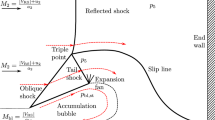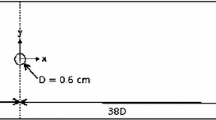Abstract
A highly resolved three-dimensional large-eddy simulation (LES) is presented for a shock tube containing a stoichiometric hydrogen–oxygen (\(\hbox {H}_2\)/\(\hbox {O}_2\)) mixture, and the results are compared against experimental results. A parametric study is conducted to test the effects of grid resolution, numerical scheme, and initial conditions before the 3D simulations are presented in detail. An approximate Riemann solver and a high-order interpolation scheme are used to solve the conservation equations of the viscous, compressible fluid and to account for turbulence behind the reflected shock. Chemical source terms are calculated by a finite-rate model. Simultaneous results of pseudo-Schlieren, temperature, pressure, and species are presented. The ignition delay time is predicted in agreement with the experiments by the three-dimensional simulations. The mechanism of mild ignition is analysed by Lagrangian tracer particles, tracking temperature histories of material particles. We observed strongly increased temperatures in the core region away from the end wall, explaining the very early occurrence of mild ignition in this case.









Similar content being viewed by others
References
Mirels, H.: Attenuation in a shock tube due to unsteady-boundary-layer action. NACA-TR-1333, National Advisory Committee for Aeronautics (1957)
White, D.R.: Influence of diaphragm opening time on shock-tube flows. J. Fluid Mech. 4(6), 585–599 (1958). https://doi.org/10.1017/s0022112058000677
Petersen, E.L., Hanson, R.K.: Nonideal effects behind reflected shock waves in a high-pressure shock tube. Shock Waves 10(6), 405–420 (2001). https://doi.org/10.1007/pl00004051
Meyer, J.W., Oppenheim, A.K.: On the shock-induced ignition of explosive gases. Proc. Combust. Inst. 13(1), 1153–1164 (1971). https://doi.org/10.1016/s0082-0784(71)80112-1
Blumenthal, R., Fieweger, K., Komp, K.H., Adomeit, G.: Gas dynamic features of self ignition of non diluted fuel/air mixtures at high pressure. Combust. Sci. Technol. 123(1–6), 1–30 (1997). https://doi.org/10.1080/00102209708935637
Chaos, M., Dryer, F.L.: Chemical-kinetic modeling of ignition delay: Considerations in interpreting shock tube data. Int. J. Chem. Kinet. 42(3), 143–150 (2010). https://doi.org/10.1002/kin.20471
Mark, H.: The interaction of a reflected shock wave with the boundary layer in a shock tube. NACA-TM-1418, National Advisory Committee for Aeronautics (1958)
Strehlow, R.A., Cohen, A.: Limitations of the reflected shock technique for studying fast chemical reactions and its application to the observation of relaxation in nitrogen and oxygen. J. Chem. Phys. 30(1), 257–265 (1959). https://doi.org/10.1063/1.1729883
Davies, L.: Influence of reflected shock and boundary-layer interaction on shock-tube flows. Phys. Fluids 12(5), I–37 (1969). https://doi.org/10.1063/1.1692625
Voevodsky, V., Soloukhin, R.: On the mechanism and explosion limits of hydrogen–oxygen chain self-ignition in shock waves. Proc. Combust. Inst. 10(1), 279–283 (1965). https://doi.org/10.1016/s0082-0784(65)80173-4
Berets, D.J., Greene, E.F., Kistiakowsky, G.B.: Gaseous detonations. I. Stationary waves in hydrogen–oxygen mixtures\(^1\). J. Am. Chem. Soc. 72(3), 1080–1086 (1950). https://doi.org/10.1021/ja01159a008
Fay, J.A.: Some experiments on the initiation of detonation in \(2{\text{ H }}_2{-}{\text{ O }}_2\) mixtures by uniform shock waves. Proc. Combust. Inst. 4(1), 501–507 (1953). https://doi.org/10.1016/s0082-0784(53)80071-8
Steinberg, M., Kaskan, W.: The ignition of combustible mixtures by shock waves. Proc. Combust. Inst. 5(1), 664–672 (1955). https://doi.org/10.1016/s0082-0784(55)80092-6
Oran, E., Young, T., Boris, J., Cohen, A.: Weak and strong ignition. I. Numerical simulations of shock tube experiments. Combust. Flame 48, 135–148 (1982). https://doi.org/10.1016/0010-2180(82)90123-7
Oran, E.S., Gamezo, V.N.: Origins of the deflagration-to-detonation transition in gas-phase combustion. Combust. Flame 148(1–2), 4–47 (2007). https://doi.org/10.1016/j.combustflame.2006.07.010
Ihme, M., Sun, Y., Deiterding, R.: Detailed simulations of shock-bifurcation and ignition of an argon-diluted hydrogen/oxygen mixture in a shock tube. 51st AIAA Aerospace Sciences Meeting including the New Horizons Forum and Aerospace Exposition Grapevine (Dallas/Ft. Worth Region), TX, AIAA Paper 2013-0538 (2013). https://doi.org/10.2514/6.2013-538
Grogan, K.P., Ihme, M.: Weak and strong ignition of hydrogen/oxygen mixtures in shock-tube systems. Proc. Combust. Inst. 35(2), 2181–2189 (2015). https://doi.org/10.1016/j.proci.2014.07.074
Khokhlov, A., Austin, J., Knisely, A.: Development of hot spots and ignition behind reflected shocks in \(2{\text{ H }}_2 + {\text{ O }}_2\). Proceedings of the 25th International Colloquium on the Dynamics of Explosions and Reactive Systems, ICDERS, Leeds, UK, Paper 020 (2015)
Dziemińska, E., Hayashi, A.K.: Auto-ignition and DDT driven by shock wave—boundary layer interaction in oxyhydrogen mixture. Int. J. Hydrogen Energy 38(10), 4185–4193 (2013). https://doi.org/10.1016/j.ijhydene.2013.01.111
Proch, F., Kempf, A.M.: Numerical analysis of the Cambridge stratified flame series using artificial thickened flame LES with tabulated premixed flame chemistry. Combust. Flame 161(10), 2627–2646 (2014). https://doi.org/10.1016/j.combustflame.2014.04.010
Rittler, A., Deng, L., Wlokas, I., Kempf, A.: Large eddy simulations of nanoparticle synthesis from flame spray pyrolysis. Proc. Combust. Inst. 36(1), 1077–1087 (2017). https://doi.org/10.1016/j.proci.2016.08.005
Rieth, M., Proch, F., Rabaçal, M., Franchetti, B., Marincola, F.C., Kempf, A.: Flamelet LES of a semi-industrial pulverized coal furnace. Combust. Flame 173, 39–56 (2016). https://doi.org/10.1016/j.combustflame.2016.07.013
Nguyen, T., Kempf, A.M.: Investigation of numerical effects on the flow and combustion in LES of ICE. Oil Gas Sci. Technol. 72(4), 25 (2017). https://doi.org/10.2516/ogst/2017023
Poinsot, T.J., Veynante, D.: Theoretical and Numerical Combustion, 3rd edn. Aquaprint, Bordeaux (2012)
Williamson, J.: Low-storage Runge–Kutta schemes. J. Comput. Phys. 35(1), 48–56 (1980). https://doi.org/10.1016/0021-9991(80)90033-9
Kitamura, K., Hashimoto, A.: Reduced dissipation AUSM-family fluxes: HR-SLAU2 and HR-AUSM\(^+\)-up for high resolution unsteady flow simulations. Comput. Fluids 126, 41–57 (2016). https://doi.org/10.1016/j.compfluid.2015.11.014
Suresh, A., Huynh, H.: Accurate monotonicity-preserving schemes with Runge–Kutta time stepping. J. Comput. Phys. 136(1), 83–99 (1997). https://doi.org/10.1006/jcph.1997.5745
Nicoud, F., Toda, H.B., Cabrit, O., Bose, S., Lee, J.: Using singular values to build a subgrid-scale model for large eddy simulations. Phys. Fluids 23(8), 085106 (2011). https://doi.org/10.1063/1.3623274
Goodwin, D.G., Moffat, H.K., Speth, R.L.: Cantera: An Object-oriented Software Toolkit for Chemical Kinetics, Thermodynamics, and Transport Processes. Version 2.4.0 (2017). https://doi.org/10.5281/zenodo.170284
Bird, R.B., Stewart, W.E., Lightfoot, E.N.: Transport Phenomena. Wiley, New York (1960)
Peters, N., Warnatz, J. (eds.): Numerical Methods in Laminar Flame Propagation. Vieweg+Teubner Verlag, Braunschweig (1982). https://doi.org/10.1007/978-3-663-14006-1
Kee, R.J., Coltrin, M.E., Glarborg, P.: Chemically Reacting Flow. Wiley, New York (2003). https://doi.org/10.1002/0471461296
Cohen, S.D., Hindmarsh, A.C., Dubois, P.F.: CVODE, a stiff/nonstiff ODE solver in C. Comput. Phys. 10(2), 138 (1996). https://doi.org/10.1063/1.4822377
Hindmarsh, A.C., Brown, P.N., Grant, K.E., Lee, S.L., Serban, R., Shumaker, D.E., Woodward, C.S.: SUNDIALS: Suite of nonlinear and differential/algebraic equation solvers. ACM Trans. Math. Softw. 31(3), 363–396 (2005). https://doi.org/10.1145/1089014.1089020
Conaire, M.Ó., Curran, H.J., Simmie, J.M., Pitz, W.J., Westbrook, C.K.: A comprehensive modeling study of hydrogen oxidation. Int. J. Chem. Kinet. 36(11), 603–622 (2004). https://doi.org/10.1002/kin.20036
Wang, L., Peters, N.: The length-scale distribution function of the distance between extremal points in passive scalar turbulence. J. Fluid Mech. 554(1), 457–475 (2006). https://doi.org/10.1017/s0022112006009128
Weber, Y.S., Oran, E.S., Boris, J.P., Anderson, J.D.: The numerical simulation of shock bifurcation near the end wall of a shock tube. Phys. Fluids 7(10), 2475–2488 (1995). https://doi.org/10.1063/1.868691
Matsuo, K., Kawagoe, S., Kage, K.: The interaction of a reflected shock wave with the boundary layer in a shock tube. Bull. JSME 17(110), 1039–1046 (1974). https://doi.org/10.1299/jsme1958.17.1039
Lamnaouer, M., Kassab, A., Divo, E., Polley, N., Garza-Urquiza, R., Petersen, E.: A conjugate axisymmetric model of a high-pressure shock-tube facility. Int. J. Numer. Methods Heat Fluid Flow 24(4), 873–890 (2014). https://doi.org/10.1108/hff-02-2013-0070
Hanson, R.K., Pang, G.A., Chakraborty, S., Ren, W., Wang, S., Davidson, D.F.: Constrained reaction volume approach for studying chemical kinetics behind reflected shock waves. Combust. Flame 160(9), 1550–1558 (2013). https://doi.org/10.1016/j.combustflame.2013.03.026
Fieweger, K., Blumenthal, R., Adomeit, G.: Self-ignition of S.I. engine model fuels: A shock tube investigation at high pressure. Combust. Flame 109(4), 599–619 (1997). https://doi.org/10.1016/s0010-2180(97)00049-7
Acknowledgements
The authors gratefully acknowledge the financial support by DFG Grant KE 1751/8-1, the computing time on magnitUDE granted by the Center for Computational Sciences and Simulation of the Universität of Duisburg-Essen through DFG INST 20876/209-1 FUGG, INST 20876/243-1 FUGG at the Zentrum für Informations- und Mediendienste, and the computing time on the supercomputer HazelHen (ACID 44116). We also want to thank Elaine Oran for inspiring discussions that improved the paper.
Author information
Authors and Affiliations
Corresponding author
Additional information
Communicated by D. Zeitoun and A. Higgins.
Publisher's Note
Springer Nature remains neutral with regard to jurisdictional claims in published maps and institutional affiliations.
Rights and permissions
About this article
Cite this article
Lipkowicz, J.T., Wlokas, I. & Kempf, A.M. Analysis of mild ignition in a shock tube using a highly resolved 3D-LES and high-order shock-capturing schemes. Shock Waves 29, 511–521 (2019). https://doi.org/10.1007/s00193-018-0867-4
Received:
Revised:
Accepted:
Published:
Issue Date:
DOI: https://doi.org/10.1007/s00193-018-0867-4




